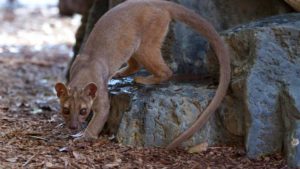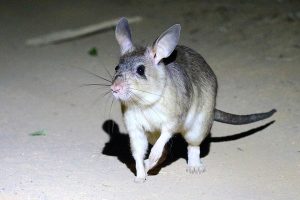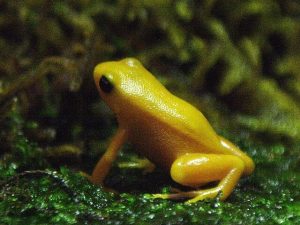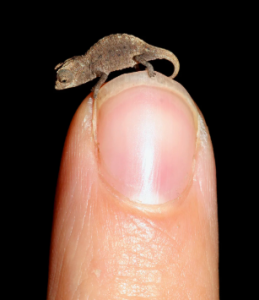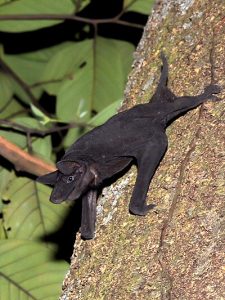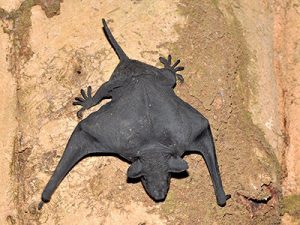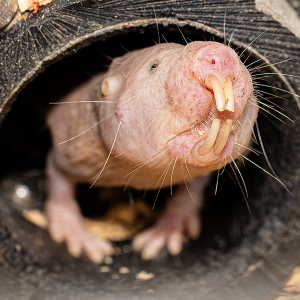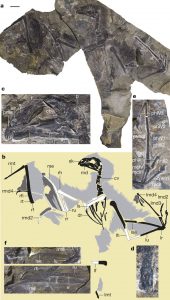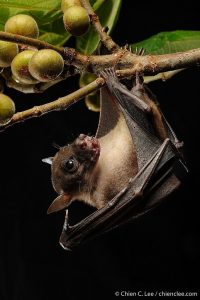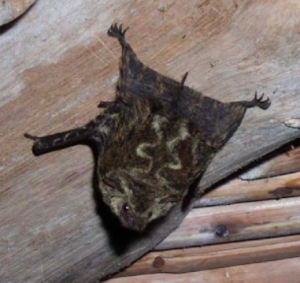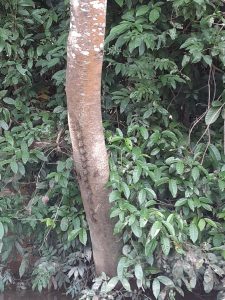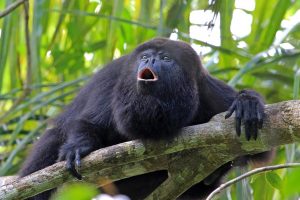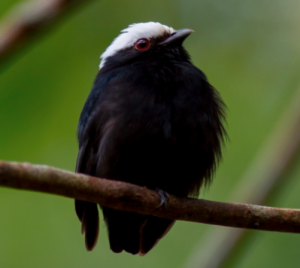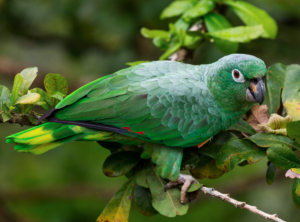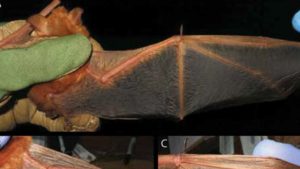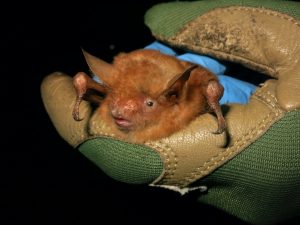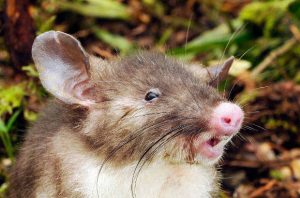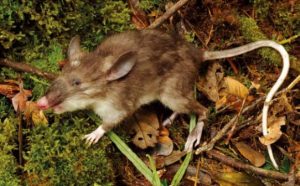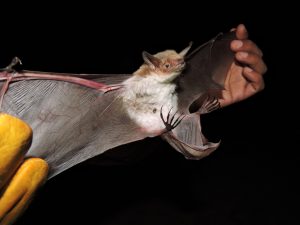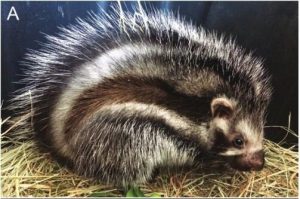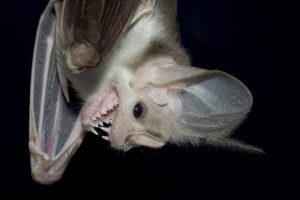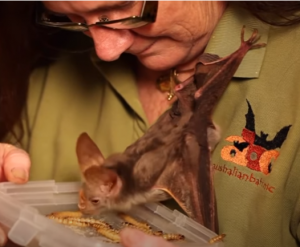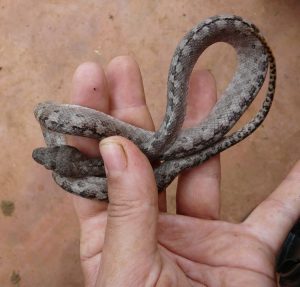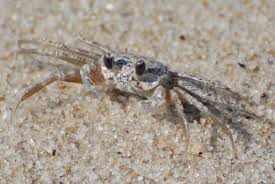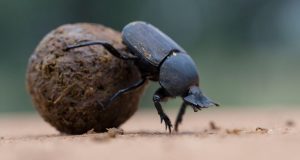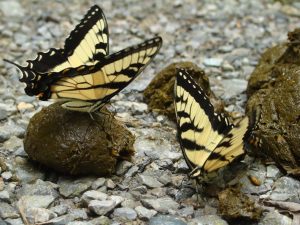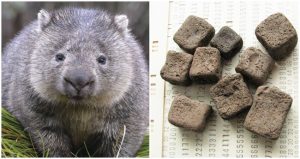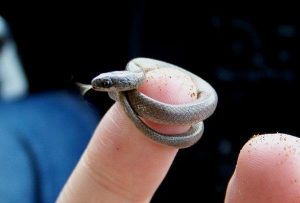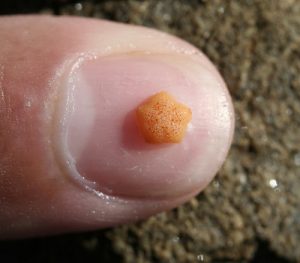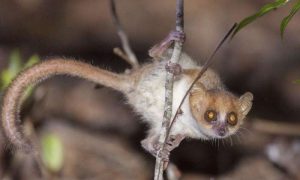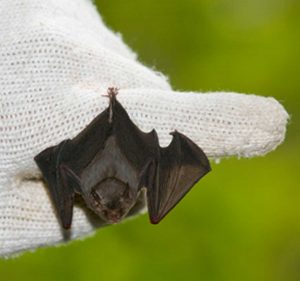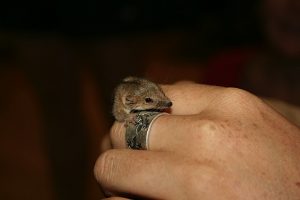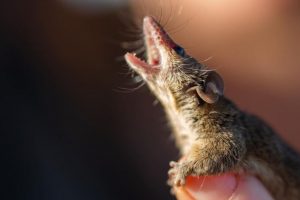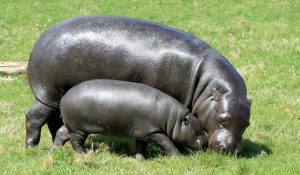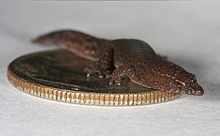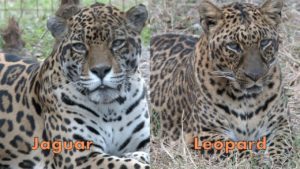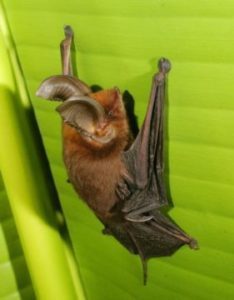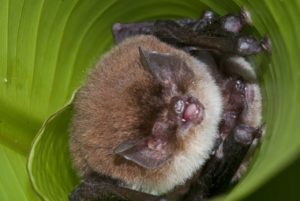Podcast: Play in new window | Download (Duration: 16:45 — 18.4MB)
This week we’re going to learn about a bunch of bats! Thanks to John, Murilo, and Alexandra for their suggestions!
Further reading:
Why Bats Can’t Walk: The Evolutionary Lock That Keeps Them Flying
On a Wing and a Song—Bats Belt out High-Pitched Tunes to Woo Mates
Why some bats hunt during the day
A pekapeka just walking around catching bugs on the ground [photo by Rod Morris, from link above]:
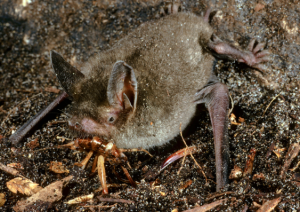
BLOOOOOOD! but a really cute smile too:
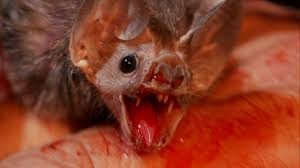
The western red bat looks ready for Halloween!
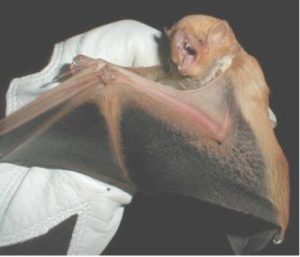
Show transcript:
Welcome to Strange Animals Podcast. I’m your host, Kate Shaw.
This week as monster month continues, we’re going to learn about bats! We’ve talked about bats in lots of previous episodes, but we have a lot of really neat information in this one that we’ve never covered before. Thanks to John, Alexandra, and Murilo for their suggestions!
John suggested we learn about diurnal bats and also asked if there are any flightless bats, maybe ones that live on islands. There are lots of island-living bats, and many birds that live on islands evolve to be flightless. It makes sense that bats might do the same thing–but I couldn’t find any information about any known bat that has lost the ability to fly.
The reason seems to be how highly derived bats are. That means they’re specialized, the only mammal known that has ever evolved true flight. Unlike birds, which don’t need to use their legs when flying, bats’ legs are actually part of the wings. The wing membranes, called patagia, stretch not just between the elongated finger bones of the bat’s hands, they also stretch between the arms and legs, and connect the legs too.
A January 2025 study comparing bat skeletons to the skeletons of birds determined that unlike in birds, where the size of the legs doesn’t have anything to do with the size of the wings, in bats the leg size and the wing size are closely related. If a bat evolves smaller wings, its legs also evolve to become smaller. That’s why there are no bats that resemble ostriches, with tiny wings but really long legs.
Another possible reason is that bat legs have evolved to point backwards compared to other animals. It’s not just the feet, the knees are also rotated backwards. That’s why bats hang upside-down when they’re not flying. Many species of bat never land on the ground, because they literally can’t walk at all.
But there are a few species of bats that can walk quite well. One is the increasingly threatened New Zealand lesser short-tailed bat. It lives in a few places in both the North and South Islands, as well as some small islands off the coast, although it used to be much more widespread. It’s also called by its Maori name, the pekapeka.
The pekapeka mainly lives in forested areas and is quite small. It’s brown with a lighter belly, and it has big ears, as do most bats. Its eyes are small and its vision isn’t very good, but it has a good sense of smell. Its wings are small so its legs are correspondingly small too, but its legs are also strong despite their size. It has a clawed thumb toe on its feet and on its wings that helps it climb around in trees when it needs to, and it also spends about half of its time on the ground. It walks just fine, crawling with its wings folded so that the ends point up and back, out of the way. And yes, its legs are rotated backwards as you’d expect in a bat, and it roosts by hanging from its feet in trees.
The pekapeka flies normally and catches insects using echolocation, just like other microbats throughout the world. It especially likes moths. Unlike almost all other bats, it finds a lot of its food on the ground too, using its sense of smell to track down spiders, insects and larvae, and other small invertebrates. It will actually dig into the dirt and leaf litter to find food. It also eats nectar and flowers, and is an important pollinator of some plants.
One great thing about the pekapeka is that the males sing to attract a mate. The sound is so high-pitched that it’s not practical to share it here, because you probably wouldn’t be able to hear it, but I’ll link to an article that has a sample bat song so you can listen.
Another bat that can walk just fine is one suggested by Murilo, the vampire bat. In movies, vampire bats are usually depicted as being humongous, as big as a person! In reality, those big bats are actually megabats, and megabats mostly eat fruit. Megabats are the ones that are sometimes called sky puppies, because they don’t rely very much on echolocation so they don’t have the complicated ears and noses that microbats do. Until recently scientists thought megabats couldn’t echolocate at all, but now we know they can, they’re just not all that good at it. The vampire bat is tiny in comparison.
There are three species of vampire bat alive today. They share the same subfamily, Desmodontinae, but have been classified in different genera because they differ considerably from each other. Their other relations are ordinary bats that eat insects, fruit, and other things that you’d expect from bats. Vampire bats really do eat blood exclusively.
The hairy-legged vampire bat is the most basal of the three species, meaning it retains traits that haven’t changed as much from its ancestors. It feeds exclusively on bird blood. The white-winged vampire bat also mostly feeds on bird blood, but it will sometimes eat the blood of mammals. It’s the common vampire bat that eats the blood of mammals.
Vampire bats probably evolved from ancestors that ate insects. Scientists hypothesize that they might have originally specialized in eating ectoparasites of other animals, or possibly insects that were attracted to animal wounds. If that’s the case, the bat would have already been eating a lot of blood along with the insects, and at some point it started taking a shortcut to getting that yummy blood. We know this has happened at least one other time, in a bird.
I thought we had talked about the red-billed oxpecker in an old episode, but if we did, I couldn’t find it. It lives throughout the savannas of sub-Saharan Africa and is brown with a bright orange bill and eyes, with a yellow eye ring. It eats ticks that it picks off rhinoceroses, cattle, and other large mammals, but it actually mainly eats blood. It’s happy to eat the ticks, because they’re full of blood, and the animals it perches on are happy that it eats ticks, but the bird will also peck at wounds so it can drink blood directly from the animal.
So it’s likely that the vampire bat started out eating ticks or other ectoparasites, then began eating the blood that oozed from the wound after it removed a tick. From there it was a short step to biting the animal to cause blood to flow, and within four million years, it was fully adapted to drinking blood.
The vampire bat has extremely sharp front teeth that stick out so that it can use them to make little cuts in an animal’s skin, after first using its teeth to shave the fur down so it can reach the skin more easily. Its fangs lack enamel, so they stay razor sharp. The vampire bat’s saliva contains anticoagulants, so the blood won’t clot right away and the bat can lick it up until it’s full, which takes about 20 minutes. It digests blood extremely quickly, so that it absorbs the nutrients from the blood and starts urinating the extra liquid within a few minutes of starting to feed. That way it can eat more and it can also stay light enough to take flight if it’s disturbed. If you were wondering, its poop is the same as other bat poop. It does echolocate, although not as expertly as bats that eat insects, but the common vampire bat also has specialized thermoreceptors on its nose that sense heat. It’s the only mammal known that can detect infrared radiation, and the only other vertebrates known that can do the same thing are some snakes.
Because vampire bats have to be able to walk around on animals to find a good spot to bite them, the bats have evolved to be able to walk, run, and even jump just fine. Like the pekapeka, it folds the ends of its wings back out of the way and basically walks on the wrists of its wings and its backwards-pointing feet.
Even though the pekapeka and the vampire bat are comfortable running around on the ground, neither has lost the ability to fly. Being able to fly seems to be baked into being a bat. So while it’s not impossible that a bat might eventually become truly flightless, it’s unlikely.
As for bats that are diurnal, or daytime bats, there are a few. A study published in 2018 determined that of the four known species of bat that routinely go out hunting during the daytime, all four live on islands where there are no predatory birds. That doesn’t mean that all bats that live in places where there aren’t any hawks or eagles or crows are active during the day, because most species are still nocturnal, but that seems to be the one requirement for a daytime bat.
John was also interested in learning about the biggest fossil bat ever found. Bats are delicate creatures and don’t fossilize very well, so the bat fossil record is really fragmentary. For example, until 2015 the oldest pekapeka fossil discovered was only 17,500 years old. In 2015, a new fossilized pekapeka ancestor was discovered on the South Island that’s been dated to 16 to 19 million years ago. The fossil shows that the bat was adapted to walk just as the modern pekapeka is, and its teeth are similar so it probably had a similar diet—but it’s estimated to be three times the size of the pekapeka! That sounds like it must have been a huge bat, but the pekapeka only weighs 15 grams at most. That’s barely more than half an ounce, or about the same weight as a CD or DVD, not counting the case. Its ancestor is estimated to have weighed as much as 40 grams, which is almost as heavy as a golf ball. It’s also what a typical vampire bat weighs, if you were wondering.
An even bigger fossil bat has been discovered in a fossil site in France, a country in Europe, and another in Tunisia, a country in North Africa. It’s called Necromantis and is estimated to have weighed as much as 47 grams, which is the same weight as two mice. Two nervous mice, because Mecromantis had strong jaws and big teeth, which suggests it ate small vertebrates–like mice. It lived between 44 and 36 million years ago in areas that were most likely tropical.
An ancestor of the vampire bat was even bigger, possibly as much as 60 grams. That’s just over 2 ounces! That’s a bit heavier than a tennis ball. It lived in South America during the Pleistocene, so recently that in addition to fossils, we also have subfossil remains. That means they’re mineralized but not yet fully fossilized. It’s called Desmodus draculae, and it was most likely still around when humans migrated to South America around 25,000 years ago. Big as it was, it still wasn’t as big as a typical megabat.
Because bat fossils are so rare, it’s led to a scientific mystery. We don’t have any fossils of bat ancestors that weren’t yet bats, but were evolving into bats. In other words, we don’t know what bats looked like before they evolved to be flying animals. The best guess is that the earliest bat ancestors were shrew-like animals that lived in trees and ate insects.
So far we haven’t mentioned any bats that live in Arizona, suggested by Alexandra, so let’s learn about the western red bat. Most bats are black, gray, or brown in color, but the western red bat is a cheerful orange with white shoulder patches and black wing membranes. It’s ready for Halloween all the time! Males are usually more brightly colored than females.
The western red bat lives throughout western North America in summer. It migrates to the southern parts of its range in winter, as far south as Central America. It’s also called the desert red bat but it actually spends most of its life in forests, where its red coat blends in with dead leaves. It eats insects and while it doesn’t spend much time on the ground, every so often it will drop to the ground to catch an insect before hopping back into the air. Not only that, but when the western red bat migrates, it will sometimes fly along with flocks of migrating birds in the daytime.
Unlike many bats, the western red bat is solitary most of the year. Also unlike most bats, instead of having just one baby at a time, it can have up to four babies in a litter. The mother has four nipples instead of just two as in most bats, and for the first three or four weeks of the babies’ lives, the mother has to carry them around while she hunts, until they learn to fly.
As a last note about bats, Murilo specifically mentioned that vampire bats carry diseases that humans can catch. (If diseases bother you, you can stop listening now because we’re almost done.) The common vampire bat does occasionally bite humans, usually the bare big toe of someone sleeping outside, or sometimes the earlobe or even the nose. Vampire bats do show a lot of resistance to blood-borne diseases, but they still spread diseases. The best way to avoid catching a disease from a vampire bat is to not sleep outside without shelter if you can avoid it, if you’re in an area of South America where vampire bats live. That means that if you’re out camping, bring a tent even if it’s hot. Also, avoid eating the meat of wild boar from South America. Not only can boars catch diseases from vampire bats that they pass on to humans, but wild boars also eat fruit partially eaten by fruit bats that also carry diseases. The fruit bats drop partially eaten fruit, the wild boar eats the fruit along with the saliva left on it by the bat, and then the boar can get sick from the saliva.
Most mammals can catch rabies. If you see a bat out in the daytime crawling on the ground, don’t assume that you’re seeing a very rare daytime bat that can also walk around like a pekapeka. Leave the bat alone and contact animal control, because most likely the poor bat has contracted rabies. If you touch the bat, even if it doesn’t bite you, you will have to get a series of rabies vaccines to make sure you don’t come down with rabies, which is an incurable disease and always fatal. That is way scarier than anything else we’ve ever talked about on monster month episodes!
You can find Strange Animals Podcast at strangeanimalspodcast.blubrry.net. That’s blueberry without any E’s. If you have questions, comments, or suggestions for future episodes, email us at strangeanimalspodcast@gmail.com. We also have a Patreon at patreon.com/strangeanimalspodcast if you’d like to support us for as little as one dollar a month and get monthly bonus episodes.
Thanks for listening!
